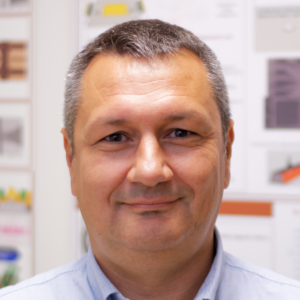Overview
The Magnetic Random Access Memories (MRAM) group develops advanced concepts in this emerging technology. The goal is to realize cells with improved thermal stability, lower power consumption and/or faster switching. Our research covers material stack deposition, nano-fabrication and electrical test evaluation, for applications as standalone memory and non-volatile logic and more recently in neuromorphic computing architectures.
Research directions
Perpendicular Anisotropy Materials
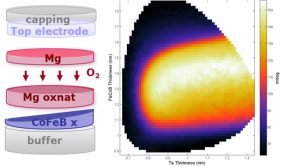
High energy barriers for spin transfer torque (STT) MRAM cells can be achieved with perpendicular anisotropy magnetic tunnel junctions. Solutions for high density MRAM cells to diameters below 20nm require continuous improvements in perpendicular surface anisotropy, while maintaining high TMR properties.
Perpendicular STT MRAM
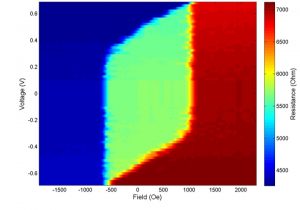
Evaluation of MRAM concepts requires simulation of expected reversal mechanisms and electrical characterization of individual cells. We aim at understanding dynamics of magnetization reversal and the expected impact of stack modifications to explore application specific optimizations.
Nanofabrication Challenges
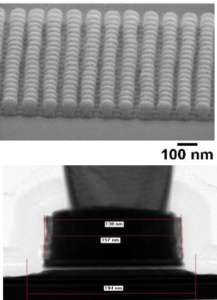
Innovation on dense MRAM using pre-patterned substrates, CMOS integration of multifunctional cells and sub-10nm lateral sizes. Tunnel junction nanofabrication in our platform is essential to evaluate MRAM concepts and performance.
Perpendicular Shape Anisotropy
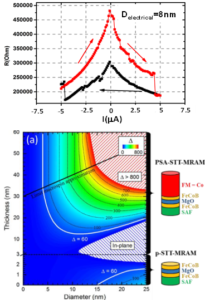
A solution for sub-10nm cell sizes uses high aspect ratios to generate perpendicular shape anisotropy providing scalable retention at the smallest cell sizes. Spin transfer torque switching is possible in these cells, where the reversal dynamics is now under study.
The team
Former members
Post-docs
- Andrey TIMOPHEEV (2014-2017)
- Van Dai NGUYEN (2016-2018)
- J. Ranier Roiz (2015-2016)
- Nikita Strelkov (2016-2019)
PhD
- Luc TILLIE (2015-2018)
- Nicolas PERRISSIN (2015-2018)
- Jyotirmoy CHATTERGEE (2014-2017)
- Hieu Tan NGUYEN (2013-2016)
- Antoine Chavent (2013-2015)
Process Engineers
- Jude GUELFFUCCI (2015-2017)
- Nathalie LAMARD (2016-2017)
- Guillaume LAVAITTE (2015-2016)
Projects
- Samsung SGMI (2014-2017)
- ANR Excalyb (2014-2017)
- Heumem (2015-2018)
- EU-FET Spice (2016-2019)
- EU Great (2016-2019)
- ERC Magical (2015-2020)
Partners
- CEA LETI, Grenoble, France
- Institut NEEL, Grenoble, France
- Crocus Technology, Grenoble, France
- Samsung, San Jose, USA
- Singulus AG, Kahl am Main, Germany
- Aarhus University, Aarhus, Denmark
- Radboud Universiteit, Neijmegen, Netherlands
Recent news
- Sustainability analysis of perpendicular anisotropy magnetic memory and platinum substitution (May 11th, 2021)

Perpendicular anisotropy Magnetic Random Access Memory (MRAM) can contribute reduced power consumption in electronic circuits. These spintronic devices also rely on materials like Co, Pt and Ru, having associated supply risk or environmental impact. A ... - Single-shot all-optical switching of magnetisation in Tb/Co multilayer-based MTJ (May 04th, 2021)

Atomistic spin simulations have been carried out to study the probability of all-optical switching of multilayered thin films. Playing with the composition of the sample, the material parameters and the fluence of the laser ... - Giant Perpendicular Magnetic Anisotropy Enhancement in MgO-Based Magnetic Tunnel Junction by Using Co/Fe Composite Layer (April 26th, 2021)

Magnetic tunnel junctions with perpendicular anisotropy form the basis of the spin-transfer torque magnetic random-access memory (STT-MRAM), which is nonvolatile, fast, dense, and has quasi-infinite write endurance and low power consumption. Here, an alternative design ... - CRYMCO – An ANR project (April 21st, 2021)

The goal of project CRYMCO is to optimize MRAM cell concepts for operation in cryogenic temperature environments. The project will explore applications for storage in conventional and quantum information processing. In the first case, ... - UFO – An ANR project (February 02nd, 2021)

UFO stands for UltraFast Opto-magneto-spintronics for Futur Nanotechnologies. UltraFast Opto-magneto-spintronics is an emerging field of research that combines the ideas and concepts of magneto-optics and opto-magnetism with spin transport phenomena, supplemented with the possibilities offered ...







